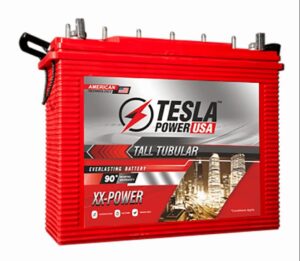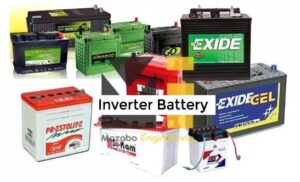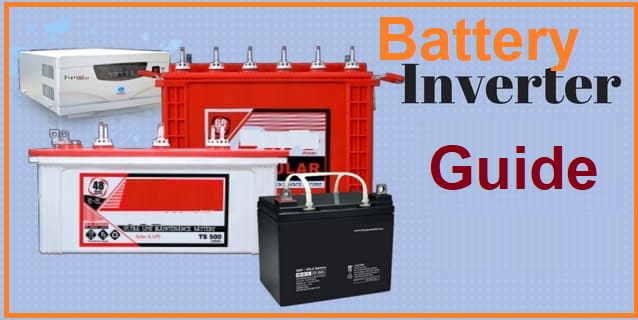Battery Inverter
- A battery inverter for home is a device that converts the direct current (DC) power from your home’s battery into alternating current (AC) power that can be used to power your household appliances. This type of inverter is particularly useful for homes that are off the grid, or that experience frequent power outages.
- As solar power becomes increasingly popular, more and more homeowners are investing in solar panels to reduce their energy bills and reduce their carbon footprint. However, a solar panel system is not complete without a battery inverter.
- A battery inverter is an essential component of a solar panel system because it converts the DC (direct current) energy generated by the solar panels into AC (alternating current) energy that can be used to power appliances and electronics in the home.
- A battery inverter also helps to regulate the energy flow between the solar panels and the batteries, ensuring that the batteries are charged efficiently and safely.

Types of Battery Inverters
There are two types of battery inverters:
Standalone and hybrid.
- Standalone battery inverters are designed specifically to work with a solar panel system, whereas hybrid battery inverters can also be used with a backup generator or the grid.
Hybrid battery inverters
- Hybrid battery inverters are more expensive than standalone battery inverters but provide greater flexibility and backup power in case of a power outage.
- When selecting a battery inverter for your home, it’s important to consider the following factors:
Power Output
- The power output of the battery inverter should match the power output of your solar panel system.
- If the battery inverter is too small, it may not be able to handle the energy generated by the solar panels.
- If it is too large, it may be inefficient and waste energy.
Efficiency:
- The efficiency of the battery inverter refers to how much energy is lost during the conversion process.
- A more efficient battery inverter will save you money on your energy bills and reduce your carbon footprint.
Battery Compatibility
- Not all battery inverters are compatible with all types of batteries. Be sure to select a battery inverter that is compatible with the type of battery you plan to use.
- Cost: Battery inverters can range in price from a few hundred dollars to several thousand dollars. Consider your budget when selecting a battery inverter, but also remember that a higher-priced inverter may be more efficient and save you money in the long run.
Warranty
How to Operate Battery Inverter
Operating a battery inverter involves several steps, which may vary depending on the specific model and brand of the inverter. However, here are some general guidelines on how to operate a battery inverter:
- Read the manual: Before operating the battery inverter, it’s important to read the manual carefully to understand the specific features and functions of your particular model.
- Connect the battery: Connect the battery to the battery inverter using the cables provided with the inverter. Make sure to connect the positive and negative terminals correctly.
- Connect the load: Connect the load (the device you want to power) to the inverter using the appropriate cables. Make sure to use the correct cable size for the load you’re connecting.
- Turn on the inverter: Turn on the inverter by pressing the power button or switch. Some models may have additional buttons or switches for specific functions, such as changing the input voltage.
- Monitor the inverter: Monitor the inverter’s status indicators, which will usually display the battery charge level, the output voltage, and other important information. Some models may have additional features, such as alarms or automatic shut-off functions.
- Turn off the inverter: When you’re finished using the inverter, turn it off by pressing the power button or switch.
- Disconnect the load and battery: Disconnect the load and battery from the inverter, following the manufacturer’s instructions.
It’s important to note that battery inverters can be dangerous if not used properly, so it’s essential to follow the manufacturer’s instructions and safety guidelines when operating them.
Best Battery Inverter Brand in the Market
As an AI language model, I do not have the ability to endorse any specific brand or product. However, I can provide you with some general information to help you choose the best battery inverter for your home.
Here are some popular battery inverter brands and models:

SMA Sunny Island:
-
- This is a hybrid battery inverter that is compatible with both on-grid and off-grid solar power systems.
- It has a high-efficiency rating and comes with a 10-year warranty.
Outback Power:
-
- This brand offers both standalone and hybrid battery inverters that are designed for residential use.
- Their inverters are known for their durability and reliability.
Tesla Powerwall:
-
- Tesla’s Powerwall is a popular option for homeowners who want a sleek and high-tech battery storage system.
- It is a hybrid battery inverter that is designed to work with Tesla’s solar panels.
- Enphase Energy:
- Enphase offers a range of battery inverters that are designed for residential use.
- Their inverters are known for their high efficiency and compatibility with a wide range of battery types.
- SolarEdge:
- SolarEdge is a popular brand for both solar panels and battery inverters.
- Their hybrid battery inverters are designed to work with their own solar panels, but they can also be used with other brands.
Summary
- When selecting a battery inverter, it’s important to consider your specific needs and preferences.
- Factors such as your energy usage, budget, and the compatibility of the inverter with your solar panel system and battery type should be taken into account
- Additionally, you may want to consult with a professional installer or energy consultant to ensure that you select the best battery inverter for your home.



